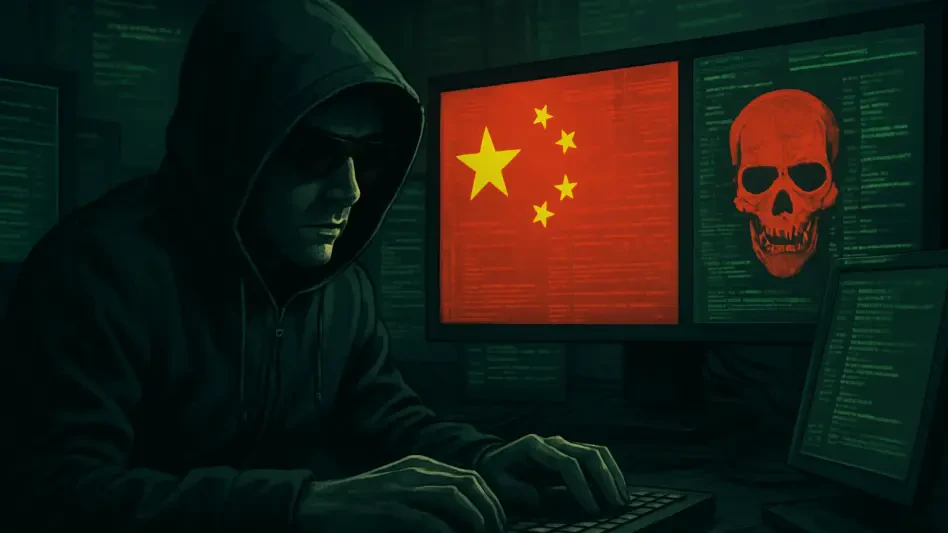In a chilling disclosure from Google, a highly sophisticated cybersecurity threat has emerged, orchestrated by hacking groups linked to China, with a specific focus on infiltrating U.S.-based technology sectors. These attackers, identified primarily as UNC5221, are targeting software-as-a-service (SaaS) providers, technology vendors, and legal-services firms with advanced, stealthy malware designed to steal sensitive data. The scale of this campaign is staggering, posing not only immediate risks to the targeted organizations but also threatening the security of their customers. With national security and international trade data at stake, the urgency to address this escalating state-sponsored cyber threat has never been more critical. This persistent operation reveals a calculated effort to exploit vulnerabilities in enterprise technology, raising alarms across industries and government bodies alike about the depth and potential long-term impact of such intrusions.
Unveiling the Cyber Threat Landscape
Sectors Under Siege and Their Strategic Importance
The scope of this cyber campaign is both targeted and deliberate, zeroing in on technology vendors, SaaS providers, and legal firms that hold pivotal roles in the U.S. economy and security framework. These sectors are not chosen at random; they are gateways to sensitive information tied directly to national security interests and international trade agreements. Hackers aim to extract data that could compromise critical operations or provide strategic advantages in global dealings. By focusing on these high-value targets, the attackers ensure that even a single breach yields substantial returns in terms of intelligence. Moreover, the ripple effect through interconnected supply chains amplifies the potential damage, as compromised service providers become conduits to infiltrate their customers’ networks, exposing a broader range of sensitive data to unauthorized access.
Beyond the immediate targets, the strategic goals of these attackers reveal a deeper intent to undermine trust in digital infrastructure. The focus on legal firms, often custodians of confidential agreements and intellectual property, suggests an aim to disrupt competitive edges in trade negotiations. Meanwhile, technology vendors and SaaS providers are critical nodes in the digital ecosystem, making them ideal entry points for widespread espionage. This calculated selection of targets underscores a sophisticated understanding of how interconnected systems can be leveraged for maximum impact. The persistent nature of these attacks, often undetected for extended periods, highlights the need for heightened vigilance and robust security measures across these vulnerable sectors to safeguard against such insidious threats.
Emerging Patterns in State-Sponsored Attacks
A broader trend of escalating state-sponsored cyberattacks is evident in this campaign, positioning UNC5221 as one of the most formidable adversaries faced by the U.S. in recent times. Cybersecurity experts have noted a marked increase in the complexity and stealth of these operations, which mirror past supply-chain attacks like SolarWinds in their approach to exploiting upstream vendors for downstream access. This pattern of leveraging trusted relationships within the tech ecosystem reveals a chilling evolution in cyber warfare tactics. The implications extend beyond immediate data theft, pointing to a long-term strategy of embedding within critical infrastructure to enable future disruptions or intelligence gathering on a massive scale.
Further analysis of this trend shows a shift toward persistent, low-profile intrusions that prioritize evasion over speed. The attackers’ ability to remain undetected for an average of 393 days speaks to a level of operational discipline rarely seen in less coordinated cybercrime efforts. Such prolonged dwell times allow for extensive reconnaissance and data exfiltration without triggering alarms, posing unique challenges to traditional security frameworks. As state-sponsored actors continue to refine their methods, the cybersecurity community faces mounting pressure to adapt with innovative detection tools and collaborative intelligence-sharing initiatives. The stakes are high, as these attacks threaten not only corporate assets but also the integrity of national defense mechanisms.
Tactics and Impact of the Cyber Campaign
Stealthy Malware and Evasive Techniques
At the heart of this cyber campaign lies Brickstorm, a sophisticated piece of malware engineered for stealth and persistence, often deployed on systems lacking endpoint detection and response (EDR) or antivirus protections, such as VMware ESXi hypervisors and email security gateways. This strategic placement ensures that the malware operates under the radar, evading conventional security measures that are typically focused on endpoint devices. The hackers’ ability to maintain a presence for an average dwell time of 393 days is a testament to the malware’s design, which prioritizes covert operation over rapid exploitation. Such prolonged undetected access allows attackers to gather extensive intelligence, map out networks, and prepare for more devastating strikes at opportune moments.
Equally concerning is the attackers’ use of dormant malware strategies to outmaneuver victim investigations. In numerous instances, the malicious code remains inactive for months while organizations probe initial signs of intrusion, only to reactivate once scrutiny subsides. This patience and tactical foresight demonstrate a level of sophistication that complicates response efforts, as security teams struggle to identify the full scope of compromise during these quiet periods. The deletion of logs further obscures the initial point of entry, leaving forensic analysts with little to trace. As a result, organizations must rethink incident response protocols, emphasizing continuous monitoring and advanced behavioral analysis to catch such elusive threats before they escalate into larger breaches.
Long-Term Espionage and Systemic Vulnerabilities
The theft of source code from enterprise technologies represents a particularly alarming facet of this campaign, as it suggests a focus on long-term espionage rather than just immediate gains. By accessing proprietary code, hackers can uncover undisclosed vulnerabilities or backdoors that may be exploited in future attacks, potentially compromising entire software ecosystems. This forward-looking strategy indicates that the current wave of intrusions might merely be the precursor to more targeted and destructive campaigns down the line. The implications for software developers are profound, as their intellectual property becomes a gateway to systemic weaknesses that could affect countless end users across industries.
Comparisons to the SolarWinds attack highlight a recurring vulnerability in supply-chain security, where trusted vendors become unwitting conduits for widespread compromise. In this campaign, attackers move seamlessly from service providers to their customers, exploiting interconnected networks to maximize their reach. The anticipated impact of these breaches is expected to unfold over the next two years, as additional victims are identified and new incidents come to light. Google’s proactive step of releasing a scanning tool and YARA rules to detect Brickstorm is a vital resource, yet the sheer complexity of investigating such an advanced adversary poses a significant hurdle. Organizations must prioritize securing their supply chains and edge infrastructure to mitigate these risks, while policymakers may need to consider stronger regulations to enforce cybersecurity standards across critical sectors.
Addressing the Ongoing Challenge
Overcoming Detection and Response Barriers
One of the most daunting aspects of this cyber campaign is the hackers’ operational security, which severely hampers detection and response efforts. By using unique IP addresses for each attack and systematically deleting logs, the attackers leave little trace of their initial access methods, making forensic analysis a near-impossible task. This deliberate obfuscation ensures that even when a breach is suspected, piecing together the full timeline of events becomes a resource-intensive endeavor. The focus on edge devices, such as Ivanti Connect Secure VPNs, further exploits common weaknesses in perimeter security that many organizations fail to adequately protect, underscoring a critical gap in current defense strategies.
Addressing these barriers requires a fundamental shift in how cybersecurity incidents are approached. Traditional reactive measures are insufficient against adversaries who operate with such stealth and adaptability. Instead, organizations need to invest in proactive threat hunting and anomaly detection systems that can identify subtle indicators of compromise before they escalate. Collaboration across industries to share threat intelligence is equally crucial, as isolated efforts are unlikely to match the coordinated tactics of state-sponsored actors. Google’s call for thorough investigations upon detecting Brickstorm signals the gravity of the situation, urging companies to act swiftly despite the inherent complexities of tracing such a shadowy threat.
Building Resilience Against Future Threats
Reflecting on the scale of this cyber campaign, it becomes evident that the actions of UNC5221 and associated groups have exposed significant vulnerabilities in U.S. technology and legal sectors. The deployment of stealth malware like Brickstorm, coupled with strategic supply-chain targeting, has inflicted considerable damage, with effects that linger long after initial breaches are detected. The theft of source code for future exploitation has set a dangerous precedent, hinting at potential disruptions yet to come. Google’s decision to publicize the threat and provide detection tools has marked a pivotal moment in raising awareness, though the road to recovery remains fraught with challenges.
Looking ahead, the path to resilience lies in actionable steps that fortify defenses against such sophisticated adversaries. Organizations must prioritize the adoption of advanced security solutions, particularly for edge infrastructure and supply-chain endpoints, to close existing gaps. Governments and the private sector should foster greater collaboration, establishing frameworks for rapid threat intelligence sharing to preempt similar campaigns. Investing in workforce training to recognize early signs of intrusion can also bolster preparedness. As the cybersecurity landscape continues to evolve, these measures offer a foundation to mitigate the long-term impact of state-sponsored cyber threats, ensuring a more secure digital future for all stakeholders.








